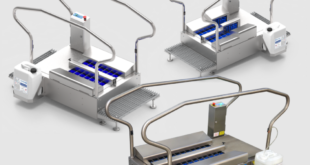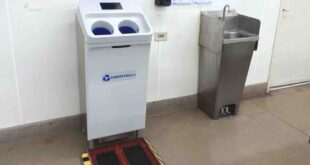Gerard Bush discusses hygienic design and servo systems for food packaging machinery
From augers to bottling systems, packaging machines for the food & beverage sector depend on fast, accurate motion systems to deliver the throughput they need. While servo motors and drives are required for their precision and dynamism, the motion solution is also subject to the stringent hygiene regulations that apply to machinery used in the sector. Maintaining hygiene is vital, and it’s important that the approach to achieve it minimises downtime to maintain productivity.
Although the domestic food manufacturing market contracted as expected last year in line with expectations resulting from the cost of living rise, the UK food and beverage packaging machinery market is projected to continue to grow. Requiring adaption throughout the sector’s value chain, a key trend is the continued consumer demand for sustainability. On the one hand, this requires increased use of sustainable materials and reduced reliance on plastic, while on the other, the government is likely to debate a further push on retailers to provide more loose, package-free produce.
For packaging machinery manufacturers, this means the future is set to be increasingly competitive. As the cost of packaging materials rise, along with rising food prices, machine builders will face demands for more productive and efficient designs. The need to optimise overall equipment effectiveness will equate to machines with increased performance and throughput. Crucially, it will also require more reliable designs that minimise downtime.
Ensuring hygiene
Alongside the increased need for higher machine productivity, ensuring hygienic safety standards is fundamental. However, to maintain machine uptime and profitability, careful management of the cleaning and hygiene maintenance process is vital. To achieve this, the emphasis for machine builders will be on designs that enable effective cleaning with the minimum of downtime.
As a cleaning process can involve high pressure and high temperature washdowns, often with aggressive chemical solutions, it is essential that this does not lead to equipment damage. This can mean costly equipment replacement, along with the downtime required for refit. Most significantly, from a hygiene standards perspective, corrosion can harbour bacteria, impacting the safety and quality of the packaging process itself.
For packaging machine builders, this challenge demands careful design consideration, particularly relating to motors. Older machine designs are often driven by motors without sufficient ingress protection, and as a result, they require shields or bags to protect them during washdown. This presents the challenge of the time required to fit the protective bags each time, plus the demand for separate cleaning by hand. Neither is this manual process a fail-safe mode of adequate motor protection, or of ensuring a sufficient washdown every time.
Even for machines with clean-in-place designs that pump cleaning solutions throughout, if a motor is not sufficiently protected, this can still give rise to the same challenges. Despite this controlled hygiene approach, the motor still needs to undergo a washdown, so they still require sufficient protection.
Hygienic motor design
To meet the demands of packaging applications, a servo motor is typically required, providing the dynamism and precision needed to ensure rapid, accurate motion. To save the machine user significant time and cost while carrying out cleaning procedures, Kollmorgen’s engineers have combined the servo capability with protection that enables the motor to undergo a thorough washdown.
A key requirement is the ability for the motor to withstand regular, high temperature, high pressure washdowns, without the risk of water ingress. To achieve this, a motor should be designed to meet the IP69K standard that can be achieved with a food-grade PTFE shaft seal that creates an impermeable barrier, along with sufficient protection for the cable connections.
High-level ingress protection should be teamed with a rounded motor housing that enables run-off, and the construction material must also prevent corrosion. Aluminium anodising can achieve this, while stainless steel is the optimum choice. A smooth surface prevents any bacterial accumulation, and to meet EHEDG (European Hygienic Engineering and Design Group) standards, its profile should not exceed 0.8μm. The motor shaft too should also adhere to these standards.
System architecture
Servo motors require the control of a servo drive, and using a decentralised system, which places control closer to the motor, is advantageous to reduce the cost, installation, and maintenance requirements of extended cabling typically required for central control. To achieve this layout, even though the servo drive isn’t in the direct vicinity of machine actuation, it will still be mounted to the packaging machine. As a result, it will require protection extending to IP67, preventing ingress from pressurised liquid spray.
To optimise a machine’s motion control specification, while achieving a hygienic design, motion engineering expertise can be invaluable. INMOCO regularly works with machine builders to specify high performance and hygienic servo motor and drive combinations from automation vendors such as Kollmorgen.
As well as sizing the solution for the desired work points and identifying the necessary control functionality, our engineers have the experience to optimise the motion solution integration into the wider machine architecture.
Gerard Bush is an Engineer at motion specialist INMOCO.
 Engineer News Network The ultimate online news and information resource for today’s engineer
Engineer News Network The ultimate online news and information resource for today’s engineer




